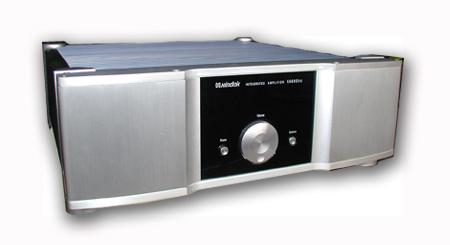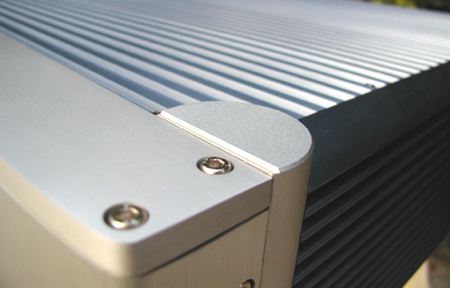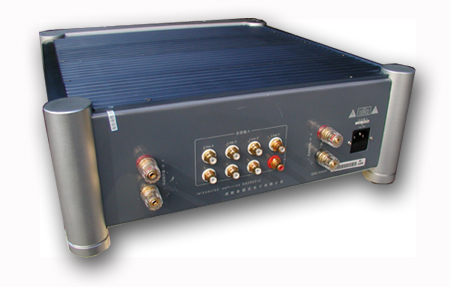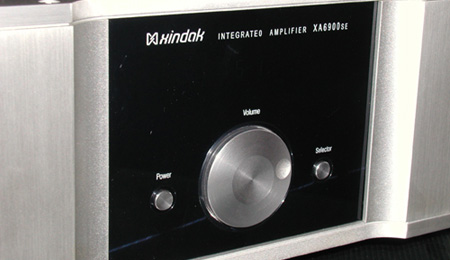You are reading the older HTML site
Positive Feedback ISSUE
12march/april 2004
xindak
XA6900SE integrated
as reviewed by Jim Grudzien, Ed Morawski, and Larry Cox

All images by Dave Clark
|
JIM GRUDZIEN'S SYSTEM LOUDSPEAKERS ELECTRONICS SOURCE CABLES ACCESSORIES
|
 The
familiar expression "love/hate" perfectly describes my relationship with the
Xindak XA6900SE integrated amplifier. I absolutely loved most things about
it, but hated others. I’ll expand on that in a moment, but first the
technical stuff. The first thing that caught my attention about this amp was
its weight, which is close to fifty pounds. This is a rock solid component.
The review piece had a silver faceplate, but the U.S. distributor tells me
that Xindak will also be offering gold and black faceplate options, which
will be very cool.
The
familiar expression "love/hate" perfectly describes my relationship with the
Xindak XA6900SE integrated amplifier. I absolutely loved most things about
it, but hated others. I’ll expand on that in a moment, but first the
technical stuff. The first thing that caught my attention about this amp was
its weight, which is close to fifty pounds. This is a rock solid component.
The review piece had a silver faceplate, but the U.S. distributor tells me
that Xindak will also be offering gold and black faceplate options, which
will be very cool.
The XA6900SE’s input incorporates two 6N3 tubes, probably made in China, and a 100-watt, pure class A, solid state output into 8 ohms. The frequency response is 20 Hz to 100 kHz (-3dB), total harmonic distortion is 0.05%, and the amp comes with a remote control that changes volume, selects source, mutes, and gives a readout of the internal temperature. The remote was rather temperamental. Sometimes I had to push the button twice to get it to do anything, and at any volume above 8 on the display, it would go up in double increments each time I pushed the button. Also, the unit switched sources while I was fast-forwarding through a CD. I would stop forwarding and have no sound, only to discover that the source on the display had changed. This was annoying.
The rear of the Xindak is well laid out, with four inputs near the middle. One set of inputs is metal, and is said to be more favorable to digital sources, so I used it to hook up my CD player. None of the inputs are specified (i.e., instead of CD, Tuner, Tape, Aux, they are labeled 1, 2, 3, 4). The speaker connections, which appear solid, are on both sides of the inputs. The knobs are coated in plastic for easy turning. There is also a detachable power cord. I used the stock cord for the review.
The unit I received had had about thirty hours on it. When I first hooked it up, it sounded very nice. After about fifteen minutes, it was sounding really good, and the more time it was on, the better it sounded. At about 100 hours, the sound really started to explode (in a good way) out of my speakers. The sound was fast, dynamic, textured, detailed, dimensional, and smooth. The imaging was rock solid, and the soundstage was expansive. The sound was warmer than most solid state amps, and the bass was incredible, rocking my world and my walls without being fat or bloated.
I was in hog heaven, enjoying every moment with this amp, but this is where the hate part started. It blew a fuse. So what, you say? Just replace it and move on? That is what I did, but I couldn’t move on. I was now getting intermittent distortion in my left speaker. I tried different cables, a different source, a different power cord, different interconnects. Same problem. I even went so far as to remove my bananas and replace them with spades at the amp end. Same problem, and it came and went for no discernible reason. It was very annoying, and it distracted from the review process. I hooked up my receiver to the system to rule out speaker damage, and the Dali Grands came through with flying colors. This is where it gets weird. I brought the amp to another reviewer’s home and it ran flawlessly for over an hour, then brought it back to my house and you guessed it—same problem.
I notified the distributor, and his response was, "The amp works flawlessly with bananas, and the cause could be a loose banana connection or cheapo banana plugs." I had my connections checked at a reputable shop, and all was well. Dali and JPS Labs make my banana connections, and they are not cheapo bananas. The next thing I tried was to switch my speaker cable connections left to right, and now got distortion out of my right speaker, so it became clear that the problem was with the amp. This leads me to question the build quality of the amp, and its long-term reliability. The Xindak comes with only a one-year parts and labor warranty (90 days on the tubes).
Hence my love/hate relationship with this amp. But there was love, too!!! Israel Kamakawiwo’ole’s Facing Future CD is a staple in my review process. The Xindak removed all of the edginess to Iz’s voice that I hear through my receiver, providing me with a delicate but weighty, detailed yet smooth presentation. His voice was very natural sounding, and the amp captured all of its subtle nuances. The voice was refined, clear, and smooth. The ukulele was light, delicate, and precise, while the bass was tight and full without being overpowering. The sound was so non-fatiguing that I could have listened for hours on end, and I did.
Mary Black’s No Frontiers is another favorite. On her rendition of "Columbus," the Xindak imaged like a champion. I could picture her dead center, with the bass and violin to her right, piano to her left, and drums and cymbals back and to the left. I could easily visualize a four-piece group playing in front of me. The bass line was so pronounced that, with a little volume, I could actually feel it, though it did not overpower the rest of the music.
On Hans Theesink’s "The Planet," on the Burmester CD III, the Xindak gave me a rich and detailed presentation of the song. Hans’ voice was smooth and relaxed, almost effortless. He was up front, with his musicians behind him. There was excellent spacing and air between the instruments, producing a well-balanced sound. Also on the CD III disc is Hugh Masekela’s cut "Stimela," in which the image conjured was very life-like. Guitar and sax were to the singer’s right, drums center back, trumpet and vocals dead center. The soundstage was huge, spilling way beyond my Grands’ physical placement. As I closed my eyes, l imagined myself sitting in the back of a dark, smoke-filled club watching a live performance with a drink on my table and smoke hovering near the ceiling, watching a group of talented musicians telling a depressing story of working in the mines in South Africa.
My general impressions of the Xindak XA6900SE were very favorable. My hours with it gave me some of the finest music listening I’ve ever experienced. This amp is fast, articulate, detailed, agile, smooth, three-dimensional. It is very dynamic, produces a huge soundstage, and was an excellent match with my speakers. On the other hand, the amp gave me problems that I have never encountered before. It may be an anomaly with my review sample. Let’s hope so. I recommend this product with reservations about its long-term reliability, but without any reservations about its sound quality. Jim Grudzien

|
ED MORAWSKI'S SYSTEM: LOUDSPEAKERS ELECTRONICS SOURCE CABLES ACCESSORIES
|
 Look
at pictures of the new Xindak XA6900 integrated amp. There is no doubt that
this a stunning, beautifully executed design. This mainland Chinese company
is making quite a name for itself—first a CD player, then an SACD player,
and now other products are reaching the American audiophile. But let me
start at the beginning.
Look
at pictures of the new Xindak XA6900 integrated amp. There is no doubt that
this a stunning, beautifully executed design. This mainland Chinese company
is making quite a name for itself—first a CD player, then an SACD player,
and now other products are reaching the American audiophile. But let me
start at the beginning.
I got three power amps to review at the same time. The XA-6950 was boxed up, and I didn’t think about it until a few weeks later, when I had finished listening to the other two amps. I was very surprised when I opened the box, to say the least.
Although I had seen photographs of Xindak’s other products, this was my first experience of one, and I was stunned at the build quality and level of craftsmanship. For a country that is still in its infancy as an audio equipment manufacturing center, this is quite an achievement. I could find not a single flaw. Even the remote is a jewel. The amplifier is sleek, clean, and downright good looking, and I especially like the four "tube" legs. All the hardware on the rear is top quality—gold-plated RCAs and what appear to be WBT binding posts. This unit could have come from any top-of-the-line audiophile manufacturer in Germany or Japan.
Anxious as I was to hear the amp, I let it warm up overnight. The display can show the amp’s internal temperature at the touch of a button. The next day, when the unit was barely warm to the touch, the temperature readout was less than 100 degrees. I figured I had waited long enough, so I inserted Keiko Matsui’s Deep Blue into my Musical Fidelity CD player. After adjusting the volume with the XA6900’s conveniently sized aluminum remote, I sat back to listen. My first impression was of almost extreme neutrality, bordering on sterility. The music, while dynamic, was too polite for my taste.
I next tried Madonna’s American Life, which has a bass line running throughout all the tracks, to say the least. This CD also has a generous helping of synthesizers, so I was expecting the Xindak to perk up a little, but the politeness remained. I also felt that the bass was lacking in weight compared to the other power amplifiers I had on hand—all of which all cost considerably more.
Celine Dion’s A New Day came next, as I wanted to see how the XA6900 handled vocals. It sounded exactly the same—cool, reserved, and very neutral. Many of you will love this amplifier for those very qualities. I crave a little more warmth and weight. I wasn’t ready to give up yet, however. Over the next week, the XA6900 saw duty in many different areas. I briefly used it in my home theater system and it performed more than adequately, but it really wasn’t meant for that, so I tried many more CDs to see if I could find its personality.
After two weeks, my initial reaction remained unchanged. This amp sounds just too sterile for me. Its soundstage is okay, a bit less wide than many. Its imaging is also okay, on a par with that of many other amplifiers. Its speed and resolution are right where they need to be as well. I tried a few different power cords and cables, but I was not really able to change the amplifier’s character in any significant way. Of course, these are my observations of the amp, in my system. The Xindak XA6900 is a beautiful amplifier, and for the money, a very good deal. If you are looking for a neutral sound that is not in any way forward, check it out. Ed Morawski

|
LARRY COX'S SYSTEM LOUDSPEAKERS ELECTRONICS SOURCE CABLES ACCESSORIES
|
 Jim
Grudzien hunted down the Xindak XA6900ES integrated amp, partly because it
was supposed to be a good match with his DALI speakers. I talked to Jim when
he first received it, and both he and his wife were impressed, so I thought
he was getting close to completing his system. Then he experienced an
intermittent failure with the amplifier, and brought it over to my house to
see if it would fail in my system.
Jim
Grudzien hunted down the Xindak XA6900ES integrated amp, partly because it
was supposed to be a good match with his DALI speakers. I talked to Jim when
he first received it, and both he and his wife were impressed, so I thought
he was getting close to completing his system. Then he experienced an
intermittent failure with the amplifier, and brought it over to my house to
see if it would fail in my system.
The amp worked properly, as one would hope with a $2000 piece of equipment. The build quality was good. We took off the hood off while the unit was playing to see if we could make it show its warts. The innards were well laid out and seemed to be well finished. With the eraser from a number 2 pencil, I lightly tapped the tubes to see if I could produce ringing or cause the intermittence. No effect. I tried the same on the input jacks and speaker connectors, to no avail. The amplifier performed flawlessly.
My experience with the Xindak was obviously limited. I listened to hear it fail, not to describe its sound. My impression was that it sounded robust—full rather than lean. The bass was well controlled, neither tight nor loose. Treble extension was fine. The sound was not quite as rich as other class A amplifiers that I have heard, like the Classe DR 3 or the Coda 12.0 I now have on hand. Imaging was good for a hybrid amp. The Xindak was a reasonable performer for its price, though its performance was not in the league of my all-tube system. To put this in context, however, E.A.R. gear seems to lead the league in liquidity, or "continuousness."
The shortfall of the Xindak amplifier was that there was a bit of grit to sustained notes. It was like having very fine sand in your shoes—you notice it but may not be bothered by it. There was also a mist that overlay the music. I don’t think the Xindak would sound bright in a different system (a Bozo no-no in my book) unless the system was already leaning that way. Comparing the Xindak to other amplifiers at or near its price, I felt that the Naim Nait 05 ($1550) had better pace and delineated musical lines more clearly. The 47 Labs Gain Card, with a mere 25-watts ($1980) was more incisive and immediate than either the Nait or the Xindak. The Kora Explorer 90S is a sweet, lower-resolution amp than any of the others I’ve mentioned, but qualifies as a seductress.
The Xindak is less suave than the Kora, less resolving than the Gain Card, and has less pace than the Nait. That said, I thought it was a good, though not exceptional performer. Would I choose it? I can’t say. I made no effort to optimize the sound with my system, as I was trying to make it fail. The fact that it had few shortcomings bodes well, but ultimately it’s the experimenting that tells you what a product can do. I didn’t experiment, so I don’t know.
A note on my system. My speakers are less efficient than Jim’s, which may push the amplifier harder, and my system is more resolving, which means that more warts will be perceived. My preamp costs more than the Xindak integrated, and the current iteration of my amplifier retails for five times the cost of the Xindak. Comparing the Xindak to my electronics was not entirely fair, but it did show what the unit could do. Larry Cox
Xindak XA6900SE integrated
Retail: $1995
Chengdu Xindak Electronics Co., Ltd.
web address: www.xindakaudio.com
US Distributor
J. C. Bertrand Audio
TEL: 603. 883. 1982
web address: www.bertrandaudio.com

